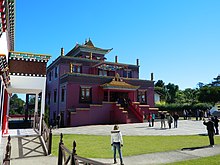Buddhism in Brazil
[4][5] Typically, early immigrants were not firstborn sons, who in Japan have primary responsibility for religious rituals, and monks were forbidden from migrating by the Japanese Ministry of Foreign Affairs.
[6] They mainly belonged to the Jōdo Shinshū sect of Pure Land Buddhism, which focuses on group veneration of the Amida Buddha, that was common in agricultural regions of Japan where most immigrants came from.
[12] While Shinto practices had often coexisted with Buddhist ones, the end of State Shintoism and the associated Cult of the Emperor caused the religion to lose its status among Japanese people.
[15] From the late 1940s through to the 1960s a number of Buddhist institutions, missions and temples were founded from the Shin, Honmon Butsuryū-shū, Nichiren-shū and Soto Zen schools.
[16]The 1955 founding of the Soto Zen Busshinji temple in São Paulo was particularly important for both its service to the Japanese Brazilian community and outreach to non-Brazilians.
[17][18] Built with fund from the local Japanese community and the Soto Zen school, of which it was the head quarters, the temple assisted in proselytising 3,000 families.
[20] Beginning in the 1960s, Takashina started Zen meditation workshops which in the 1970s opened up to non-Japanese attendees including public figures such as Nise da Silveira and Orides Fontela.
Azevedo was an engineer who had published and taught on Asian philosophy at the Pontifical Catholic University in Rio de Janeiro among other institutions[17][21] In 1955 he founded the Buddhist Society of Brazil (Sociedade Budista do Brasil) which arranged film screenings and lectures with materials provided by the Sri Lankan and Indian embassies.
[17] Similar to other western countries in the 1960s and 1970s, early non-Asian Brazilian Buddhist practitioners were attracted to Buddhism through the counterculture's interest in eastern spirituality.
[35] Japanese schools and sects of Buddhism, such as Soto Zen, Nichiren Honmon Butsuryu Shu, Jodo-shu, Jodo Shinshu (which district of the Nishi Hongan-ji is known as South America Hongwanji Mission) and Soka Gakkai have a strong presence in Brazil.
Other Japanese traditions present in Brazil include Shingon, Tendai, Nichiren-shū and Nichiren Shōshū schools, albeit in somewhat modest numbers.
The Chinese Chan tradition of Mahayana Buddhism is centered on the city of Cotia's Zu Lai Temple and its companion Buddhist University in São Paulo State, both of which were opened in 2003 by Fo Guang Shan Order from Taiwan.
[37] The Vietnamese Zen school of Thich Nhat Hanh maintains temples and sangha in the cities of São Paulo and Rio de Janeiro.
Since the 1970s it has maintained simple installations built with voluntary work which have hosted visiting monks from Sri Lanka and other Theravada countries.
It maintains affiliated groups in Rio de Janeiro, Belo Horizonte, São Paulo and Curitiba, and has invited many international teachers through the years.
Chagdud Tulku Rinpoche relocated the headquarters of his international organization to Três Coroas in Rio Grande do Sul State where he spent the last few years of his life.
The activities of Buddhist groups are however a bit restricted due to the linguistic geography of Brazil - since it is a non-Spanish speaking country in Latin America.



